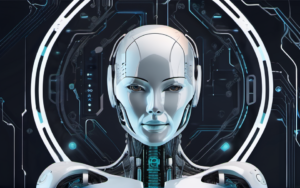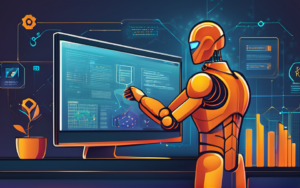The world of work is undergoing a dramatic transformation, driven by technological advancements and evolving societal preferences. Cybersecurity plays a critical role in navigating this changing landscape, ensuring the safety and security of individuals, businesses, and the broader digital ecosystem.
The Evolving Landscape of Work
The Rise of Remote Work and Hybrid Models
The COVID-19 pandemic accelerated the adoption of remote work and hybrid work models, blurring the lines between traditional office environments and home offices. This shift has significantly impacted the way businesses operate and has introduced new cybersecurity challenges. Employees are accessing sensitive data and company networks from various locations, increasing the risk of unauthorized access and data breaches.
The Proliferation of Connected Devices and Data
The proliferation of connected devices, such as smartphones, laptops, tablets, and IoT devices, has created a vast network of potential entry points for cyberattacks. With an increasingly interconnected workforce, data is constantly flowing between devices and systems, making it crucial to ensure the security of these connections.
The Growing Threat of Cyberattacks
Cyberattacks are becoming more sophisticated and frequent, targeting businesses and individuals alike. From ransomware attacks to phishing scams, cybercriminals are constantly innovating their tactics to exploit vulnerabilities and gain access to valuable information. The rise of remote work has further amplified these threats, as employees working from home are often less aware of cybersecurity best practices and may be more susceptible to phishing attempts.
Cybersecurity as a Cornerstone of Future Work
Protecting Sensitive Data and Intellectual Property
As businesses continue to embrace digital transformation and store more sensitive information online, cybersecurity becomes paramount in protecting confidential data and intellectual property. This includes personal information, financial records, trade secrets, and other critical assets.
Ensuring Business Continuity and Resilience
Cyberattacks can disrupt business operations, causing downtime, data loss, and financial losses. Robust cybersecurity measures are essential for ensuring business continuity and resilience. This involves implementing strong security controls, establishing disaster recovery plans, and conducting regular cybersecurity assessments to identify and mitigate potential risks.
Maintaining Employee Productivity and Trust
Cybersecurity threats can significantly impact employee productivity and morale. Fear of data breaches and cyberattacks can lead to decreased employee trust and a decline in overall productivity. Building a strong cybersecurity culture within an organization helps foster trust and confidence among employees, enabling them to focus on their work without worrying about security risks.
Key Cybersecurity Considerations for the Future of Work
Data Privacy and Compliance
Data privacy and compliance are critical considerations in the future of work. With the increasing volume of personal data being collected and processed, businesses must ensure they adhere to relevant data privacy regulations, such as the General Data Protection Regulation (GDPR) and the California Consumer Privacy Act (CCPA).
Secure Remote Access and Collaboration
Securing remote access and collaboration is paramount for organizations with remote or hybrid workforces. Businesses need to implement secure virtual private networks (VPNs), multi-factor authentication (MFA), and other access control measures to protect sensitive data and prevent unauthorized access.
Employee Cybersecurity Awareness and Training
Investing in employee cybersecurity awareness and training is crucial for mitigating the risk of human error. Employees should be educated about best practices for password security, phishing prevention, data protection, and incident reporting. Regular cybersecurity training programs help keep employees informed about emerging threats and equip them with the skills to protect themselves and their organizations.
Threat Intelligence and Incident Response
Staying ahead of emerging threats requires continuous threat intelligence gathering and analysis. This involves monitoring the cybersecurity landscape, identifying potential vulnerabilities, and implementing proactive measures to mitigate risks. Organizations also need to have well-defined incident response plans to quickly and effectively address cyberattacks when they occur.
Emerging Technologies and Cybersecurity
Artificial Intelligence (AI) and Machine Learning (ML)
AI and ML are revolutionizing cybersecurity, enabling organizations to automate threat detection, analyze large volumes of data, and predict future attacks. These technologies can help identify suspicious activities, detect anomalies, and respond to threats more effectively.
Blockchain and Distributed Ledger Technology
Blockchain and distributed ledger technology offer a secure and transparent way to manage data and transactions. These technologies can be used to enhance cybersecurity by creating tamper-proof records and securing data access.
The Internet of Things (IoT) and Edge Computing
The growing adoption of IoT devices and edge computing presents new cybersecurity challenges. Organizations need to implement security measures to protect IoT devices and data stored at the edge, ensuring secure communication and data integrity.
A Secure Future of Work
The future of work is inextricably linked to cybersecurity. By embracing proactive cybersecurity measures, organizations can create a secure and resilient digital environment where employees can thrive. Investing in cybersecurity technologies, training, and a culture of awareness is crucial for navigating the evolving landscape of work and protecting against emerging threats.
Collaboration and innovation are key to building a secure future of work. Businesses, governments, and cybersecurity professionals must work together to develop new technologies and best practices to address evolving threats and protect the digital ecosystem. By fostering a culture of cybersecurity awareness, individuals and organizations can collectively contribute to a safer and more secure digital future.



